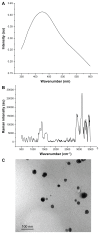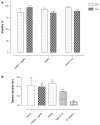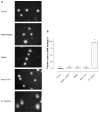Cytocompatible antifungal acrylic resin containing silver nanoparticles for dentures
- PMID: 22969297
- PMCID: PMC3435119
- DOI: 10.2147/IJN.S32391
Cytocompatible antifungal acrylic resin containing silver nanoparticles for dentures
Abstract
Background: Inhibition of Candida albicans on denture resins could play a significant role in preventing the development of denture stomatitis. The safety of a new dental material with antifungal properties was analyzed in this work.
Methods: Poly(methyl methacrylate) [PMMA] discs and PMMA-silver nanoparticle discs were formulated, with the commercial acrylic resin, Nature-Cryl™, used as a control. Silver nanoparticles were synthesized and characterized by ultraviolet-visible spectroscopy, dispersive Raman spectroscopy, and transmission electron microscopy. The antifungal effect was assessed using a luminescent microbial cell viability assay. Biocompatibility tests were carried out using NIH-3T3 mouse embryonic fibroblasts and a Jurkat human lymphocyte cell line. Cells were cultured for 24 or 72 hours in the presence or absence of the polymer formulations and analyzed using three different tests, ie, cellular viability by 3-(4,5-dimethylthiazol-2-yl)-2,5-diphenyltetrazolium bromide (MTT) assay, and cell proliferation by enzyme-linked immunosorbent assay BrdU, and genomic DNA damage (Comet assay). Finally, the samples were evaluated mechanically, and the polymer-bearing silver nanoparticles were analyzed microscopically to evaluate dispersion of the nanoparticles.
Results: The results show that PMMA-silver nanoparticle discs significantly reduce adherence of C. albicans and do not affect metabolism or proliferation. They also appear not to cause genotoxic damage to cells.
Conclusion: The present work has developed a new biocompatible antifungal PMMA denture base material.
Keywords: Candida albicans; antifungal effect; cytotoxicity; dental polymers; denture bases; genotoxicity.
Figures




Similar articles
-
Enhancing antifungal and antibacterial properties of denture resins with nystatin-coated silver nanoparticles.Sci Rep. 2024 Oct 10;14(1):23770. doi: 10.1038/s41598-024-74465-7. Sci Rep. 2024. PMID: 39390054 Free PMC article.
-
The antifungal activity and cytotoxicity of silver containing denture base material.Niger J Clin Pract. 2017 Mar;20(3):290-295. doi: 10.4103/1119-3077.181362. Niger J Clin Pract. 2017. PMID: 28256482
-
Effect of a denture base acrylic resin containing silver nanoparticles on Candida albicans adhesion and biofilm formation.Gerodontology. 2016 Jun;33(2):209-16. doi: 10.1111/ger.12142. Epub 2014 Jul 28. Gerodontology. 2016. PMID: 25070079
-
Current perspectives and the future of Candida albicans-associated denture stomatitis treatment.Dent Med Probl. 2020 Jan-Mar;57(1):95-102. doi: 10.17219/dmp/112861. Dent Med Probl. 2020. PMID: 32307934 Review.
-
Nanoparticle-modified PMMA to prevent denture stomatitis: a systematic review.Arch Microbiol. 2021 Dec 24;204(1):75. doi: 10.1007/s00203-021-02653-4. Arch Microbiol. 2021. PMID: 34952957
Cited by
-
Antifungal and Cytotoxic Evaluation of Photochemically Synthesized Heparin-Coated Gold and Silver Nanoparticles.Molecules. 2020 Jun 19;25(12):2849. doi: 10.3390/molecules25122849. Molecules. 2020. PMID: 32575630 Free PMC article.
-
Effect of Antibacterial Silver-Releasing Filler on the Physicochemical Properties of Poly(Methyl Methacrylate) Denture Base Material.Materials (Basel). 2019 Dec 11;12(24):4146. doi: 10.3390/ma12244146. Materials (Basel). 2019. PMID: 31835665 Free PMC article.
-
In vitro Comparative Study of Fibroblastic Behaviour on Polymethacrylate (PMMA) and Lithium Disilicate Polymer Surfaces.Polymers (Basel). 2019 Apr 25;11(4):744. doi: 10.3390/polym11040744. Polymers (Basel). 2019. PMID: 31027245 Free PMC article.
-
Antimicrobial Efficacy of Silver Nanoparticles against Candida Albicans.Materials (Basel). 2022 Aug 18;15(16):5666. doi: 10.3390/ma15165666. Materials (Basel). 2022. PMID: 36013803 Free PMC article. Review.
-
Silver Nanoparticles (AgNPs) Incorporation into Polymethyl Methacrylate (PMMA) for Dental Appliance Fabrication: A Systematic Review and Meta-Analysis of Mechanical Properties.Int J Mol Sci. 2024 Nov 25;25(23):12645. doi: 10.3390/ijms252312645. Int J Mol Sci. 2024. PMID: 39684356 Free PMC article.
References
-
- Shim JS, Watts DC. An examination of the stress distribution in a soft-lined acrylic resin mandibular complete denture by finite element analysis. Int J Prosthodont. 2000;13:19–24. - PubMed
-
- Waters MGJ, Williams DW, Jagger RG, Lewis MAO. Adherence of Candida albicans to experimental denture soft lining materials. J Prosthet Dent. 1997;77:306–312. - PubMed
-
- Coco BJ, Bagg J, Cross LJ, Jose A, Cross J, Ramage G. Mixed Candida albicans and Candida glabrata populations associated with the pathogenesis of denture stomatitis. Oral Microbiol Immunol. 2008;23:377–383. - PubMed
-
- Yildirim MS, Hasanreisoglu U, Hasirci N, Sultan N. Adherence of Candida albicans to glow-discharge modifies acrylic denture base polymers. J Oral Rehabil. 2005;32:518–525. - PubMed
-
- Diaz-Arnold AM, Vargas MA, Shaull KL. Flexural and fatigue strengths of denture base resin. J Prosthet Dent. 2008;100:47–51. - PubMed
Publication types
MeSH terms
Substances
LinkOut - more resources
Full Text Sources
Other Literature Sources
Medical

